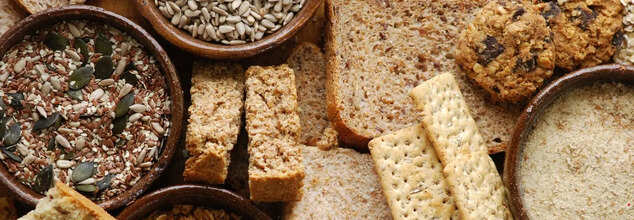- Health Conditions A-Z
- Health & Wellness
- Nutrition
- Fitness
- Health News
- Ayurveda
- Videos
- Medicine A-Z
- Parenting
Is There A Right Time To Consume Fibre?

Fibre (Credit: Canva)
Fibre, also known as roughage, is important for your overall health. A person needs fibre for digestion, weight control, to manage cholesterol and blood sugar and to strengthen bones. However, have you ever wondered if there is a right time to consume fibre and its supplements?
How Much Fibre Does One Require In A Day?The recommended daily intake of fibre is 25 grams per day for women and 38 grams per day for men. However, some experts estimate as much as 95 per cent of the population doesn’t ingest this much fibre, and may require fibre supplements due to dietary and age restrictions. On the other hand, ingesting too much fibre, while uncommon for most people, can lead to several uncomfortable digestive and health-related side effects.
Does Timing Matter?
No, Fibre can be consumed throughout the day. However, one needs to be careful while consuming fibre supplements. There is limited research which underscores that timing does matter. Many studies suggest taking fibre supplements at meal times can help your body absorb them better and may make them more effective. No matter when you consume the supplements, consistency is the key. Irregular intake of fibre supplements can trigger discomfort like bloating, gas, and changing bowel patterns.
Should You Take It With Food?
Most research suggests that taking fibre supplements with food can help improve digestion and prevent digestive discomfort. Taking fibre before a meal may help control your appetite and help you feel full. Taking it after a meal may support digestion by bulking up your stool. Some people may experience discomfort when taking a fibre supplement too close to mealtimes. Unless your healthcare provider or registered dietitian says otherwise, consider taking fibre at least 30 minutes before or after eating. You should also drink plenty of water.
What Happens When You Consume Excessive Fibre?
Consuming excess fibre or its supplements can result in bloating. Insoluble fibre found in whole grains, vegetables, and nuts, can increase gas production during digestion, causing bloating. It can also cause abdominal pain. Too much fibre can cause the digestive system to work harder than usual, leading to abdominal cramping or discomfort. This occurs as fibre moves slowly through the intestines, increasing the workload on the digestive muscles.
Flatulence (Gas) is another issue. Fibre-rich foods, especially legumes, vegetables, and grains, produce gas as they break down in the intestines. This is a normal byproduct of digestion, but excessive fibre can lead to more gas than the body can comfortably handle.
Soluble fibre, found in oats, beans, and fruits, absorbs water, which can lead to overly loose stools or diarrhoea, as excess water may remain in the intestines. On the flip side, an abrupt increase in fibre without enough water intake can cause constipation. Fibre requires water to move smoothly through the digestive tract, so dehydration or insufficient hydration can lead to harder stools.
High-fibre foods tend to be bulkier, and consuming too much can lead to temporary weight gain due to water retention and slower movement of fibre through the digestive tract. Additionally, fibre can make you feel fuller, causing temporary bloating. Excessive fibre intake can cause a blockage in the intestines, particularly in people with Crohn’s disease or other inflammatory bowel conditions. Since fibre isn’t fully broken down, it can accumulate, potentially causing an obstruction.
Fibre helps slow down the absorption of sugar, leading to more stable blood sugar levels. However, too much fibre may lower blood sugar too drastically, which is a concern for people with diabetes who may be monitoring their blood sugar levels closely.
Daily Coffee Consumption May Slow Biological Aging by Five Years, Experts Suggest

Credits: Canva
A new study suggests that drinking coffee could help certain individuals slow their biological ageing. Researchers found that consuming up to four cups a day may give some people a biological advantage, effectively making their cells appear five years younger than those who abstain. The study, published in BMJ Mental Health, focused on people with severe mental illnesses, including schizophrenia, bipolar disorder, and psychosis.
How Coffee Might Affect Ageing
The scientists linked this effect to coffee’s high antioxidant content, which appears to protect and lengthen telomeres—the protective caps at the ends of chromosomes. Telomeres function like the plastic tips on shoelaces, preventing chromosomes from fraying. Normally, telomeres shorten naturally as we age, but in people with major psychiatric conditions, this process is often accelerated, contributing to premature cellular ageing.
According to News Medical, coffee’s antioxidants can reduce oxidative stress, a factor that speeds up telomere shortening and biological ageing. By consuming the optimal amount, individuals may slow this process, potentially gaining the equivalent of five years of cellular youth.
The Study: Coffee, Mental Health, and Telomeres
The study observed 436 adults, including 259 participants with schizophrenia and the remainder with affective disorders like bipolar disorder or major depressive disorder with psychotic features. Researchers analyzed participants’ coffee consumption and its impact on telomere length.
Results showed that drinking up to four cups daily was associated with longer telomeres. However, consuming more than five cups each day did not provide additional benefits; in fact, heavy coffee drinkers were biologically older compared to those consuming one or two cups. This highlights the importance of moderation, as excessive caffeine intake may lead to cellular stress and telomere shortening.
The study authors emphasized that while this research cannot definitively prove causation—because it was observational—coffee’s established health benefits make it a plausible contributor to preserving cellular health. As they noted: “Telomeres are highly sensitive to both oxidative stress and inflammation, further highlighting how coffee intake could help maintain cellular integrity in a population predisposed to accelerated ageing.”
Guidelines and Considerations
Global health authorities generally recommend limiting caffeine intake to around 400 mg per day, roughly equivalent to four cups of coffee. Staying within this range seems to provide the protective effects without overloading the body.
The researchers also acknowledged some limitations in the study. They did not track other sources of caffeine participants may have consumed, nor did they account for the type of coffee or the time of day it was consumed, factors that could influence outcomes.
Overall, the study reinforces the idea that moderate coffee consumption can be a simple lifestyle choice with potential long-term benefits for mental health populations and, possibly, the general population as well.
Can Your Morning Coffee Raise Your Blood Pressure? Cardiologist Weighs In

Credits: Canva
Americans reach for coffee more often than any other drink, and studies continue to show that a couple of daily cups suit most people and may even support overall health. At the same time, nearly half of U.S. adults live with high blood pressure, defined as a systolic reading above 130 mmHg or a diastolic reading above 80 mmHg.
This raises a natural question. Does caffeine play a part in rising blood pressure levels? Is our strong preference for coffee adding to the problem, or could regular coffee intake possibly help keep blood pressure lower?
Coffee And High Blood Pressure: Is There A Link?
Many people enjoy coffee because it sharpens focus and lifts energy. That same stimulating action is also what can nudge blood pressure upward for a short while. John Higgins, MD, a cardiologist and professor of medicine at UTHealth Houston, agrees that this happens and notes that the general answer is yes. Moderate coffee use is usually acceptable for people whose blood pressure is stable or only slightly raised, though individuals react differently. While caffeine can push readings higher for a brief period, long-term drinking patterns tell another story.
Several studies report no added risk of hypertension among people who drink coffee often. A review of 13 cohort studies found no clear link between coffee intake and the development of high blood pressure. A separate 2023 review even noted that heavier coffee consumption was tied to a 7 percent lower risk of hypertension. The evidence suggests that people who drink coffee regularly tend to build tolerance to caffeine’s short-lived effect on blood pressure.
The 2025 AHA/ACC Hypertension Guideline does not list specific limits for coffee, and the American Heart Association states that moderate amounts appear fine for healthy adults.
How Much Coffee Is Safe To Consume For Blood Pressure Patients?
There is no set rule, but research supports one to three cups a day for most people whose blood pressure is well controlled.
Remember that caffeine levels can vary quite a bit depending on the brewing method, and it is wise to think about your total caffeine intake, including tea, soft drinks, and energy drinks.
Keep the following points in mind when having coffee:
- Choose your add-ins carefully. Sugar, flavored syrups, and full-fat milk can lead to weight gain and metabolic issues, both of which raise blood pressure risk and may add to caffeine’s influence.
- Avoid drinking coffee late in the afternoon. Coffee taken after two or three o’clock can disturb sleep, and poor sleep on its own can worsen blood pressure.
- Allow some time before checking your blood pressure. Coffee can cause a temporary rise, giving you an inaccurate reading. If you want to see how caffeine affects you, measure your pressure before drinking and again 30 to 60 minutes later.
Who Should Avoid Drinking Coffee?
Drinking coffee is generally safe for those with steady or slightly raised blood pressure, and the greater concern usually lies with uncontrolled hypertension. Still, people who are sensitive to caffeine or have poorly managed blood pressure should be more careful.
Extra caution is advised if you have:
- Uncontrolled stage 2 or 3 hypertension
- Organ damage tied to long-standing high blood pressure or other chronic illnesses
- Heart rhythm problems, particularly atrial fibrillation
- Conditions such as hypertrophic cardiomyopathy
In these situations, consider limiting or avoiding caffeinated coffee until your readings improve. Keep in mind that coffee is only one part of overall blood pressure care. Do not overlook reducing sodium intake, staying active, managing weight, and following prescribed treatment.
Fact Check: Can Diet Really Treat ADHD?

Credits: Canva
"ADHD typically is addressed by behavioral changes and therapy, but did you know that the actual treatment for ADHD lies in the food and the nutrition that you consume," is a claim made by Manjari Chandra, a nutritional medicine practitioner. She shares that mood and food are linked. While it is true that science has long revealed that what you eat could impact your mood, but does it mean it can cure a mental health disorder?
The nutritionist pointing out that the "actual treatment for ADHD lies in food" has raised eye brows. While it is true that what you eat impacts your brain health, it cannot simply fix ADHD.
Another is a claim by Be Medic Academy, where they have posted on there Instagram channel that ADHD Can Be Treated Through Diet. The reel says, "In India, 58% of people are suffering from mental and emotional problems like ADHD, GAD, stress, depression, etc., and these can be cured only and only through lifestyle changes and diet."
To dig deeper into the claim, the Health and Me ran a fact check on it.
What Did We Find About The Claim That Your Diet Can Treat ADED?
Dr Miguel Toribio-Mateas, who is a clinical neurologist, and is known for his informational videos on ADHD points out that there is a link between nutrition, ADHD, and other brain health disorders, however, this, alone cannot treat ADHD.
Dr Mateas says that one can tackle the symptoms of ADHD through gut-brain axis. One can increase fibers, inulin, which can be found in red chicory and have food rich in polyphenols. Other components like isoflavone or other antioxidants could "actually go throughout your body and regulate loads of different functions in the body." However, the video notes that diet cannot alone be the cure.
Experts and doctors have pointed out that there is no scientific or medical consensus to back the claim that diet alone can cure ADHD. In fact, a recent study in Current Nutrition Report noted that supplementing the diet with zinc and iron could reduce the severity of ADHD symptoms, however, it did not mean that it can cure ADHD altogether.
Another study led by Olweya Mohammed Abd El Baaki et.al., noted that reduced intake of carbohydrates and proteins was linked to improvements in ADHD symptoms. All studies noted that diet can manage the symptoms, however, it cannot cure the condition on its own.
Dr Rahul Chwala, who is an associate consultant in the Department of Neurology at PSRI Hospitals in New Delhi tells Medical Dialogues, "The claim that ADHD can be treated solely through diet is false. While certain dietary modifications, like reducing processed foods, artificial additives and ensuring balanced nutrition, may support overall brain health and behavior, they do not cure or treat ADHD."
The doctor says that ADHD is a neurodevelopmental disorder with complex genetic and neurological factors. "Evidence based treatments primarily includes behavioral therapy and medications such as stimulants [are used for treatment]. Dietary interventions can complement, but not replace medical management."
© 2024 Bennett, Coleman & Company Limited

